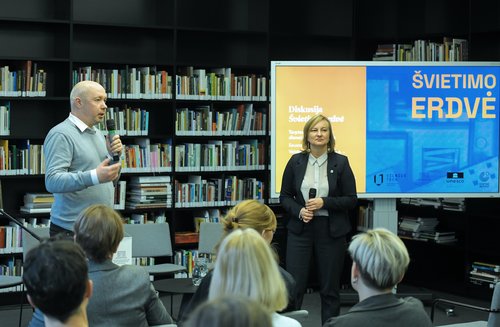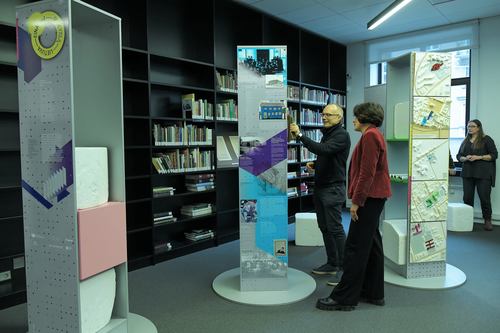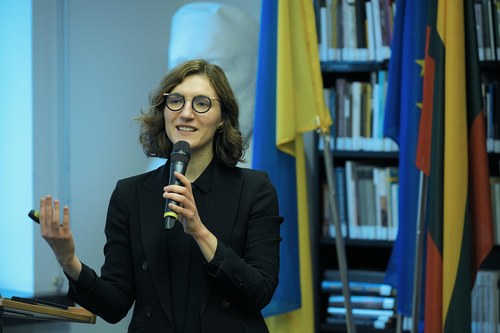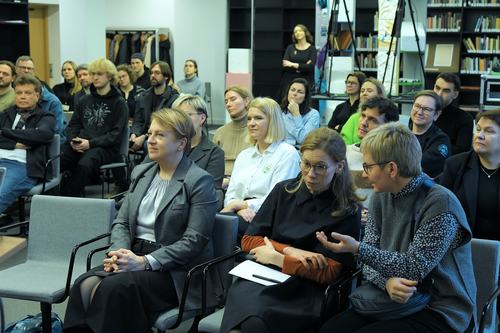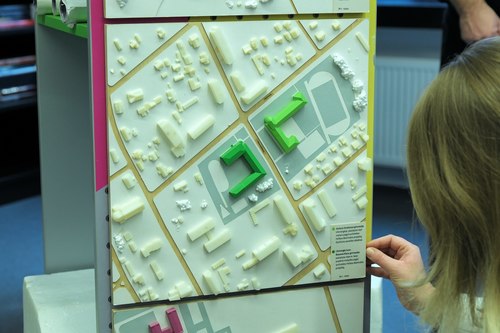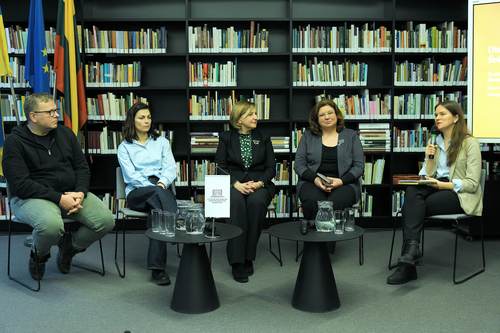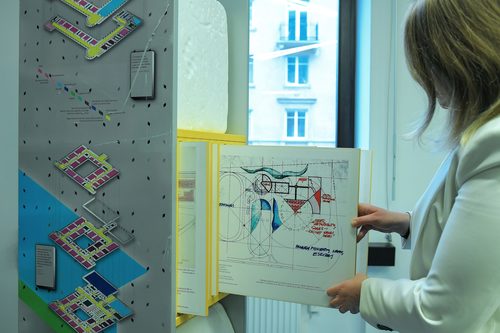Home
About University
News
Architect Barbara Pampe: “A School is Not Just a Place for Learning, but Also a Living Space”
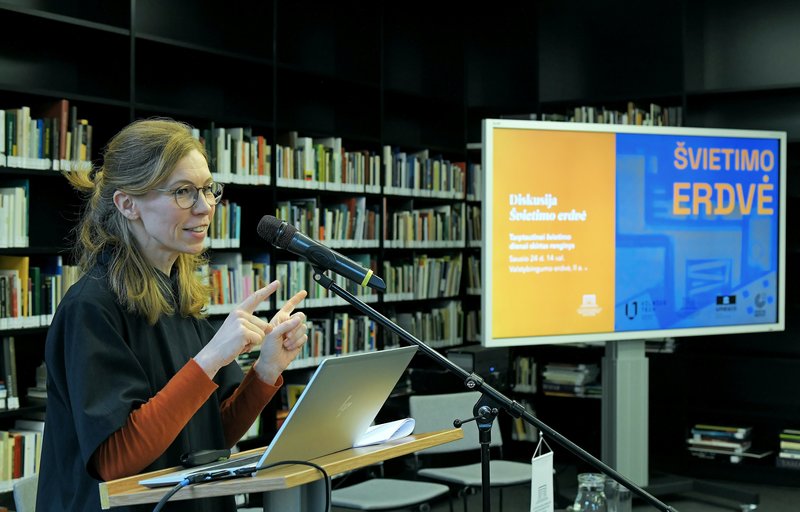
2025-01-29
Architect Barbara Pampe: “A School is Not Just a Place for Learning, but Also a Living Space”
Schools in Lithuania are embracing change and opening their doors to professionals from various fields. But how many experts—and of what kind—are needed to create a school that meets all educational needs? The community at the Faculty of Architecture at Vilnius Gediminas Technical University (VILNIUS TECH) invited the public to join a discussion on educational spaces.
“Motivated and collaborative teachers and students could make a school work even under a bridge—but how do we create an environment that makes the learning process even more effective?” asks VILNIUS TECH associate professor Liutauras Nekrošius. Opening the event, he pointed out that while many schools operate in standard buildings, each of them delivers education in a unique way. This highlights the need for both indoor and outdoor space transformations to meet modern learning needs. “In the past, school communities weren’t asked what their school should look like. Now, we are taking the first steps in fostering collaboration between professionals from different fields to shape educational spaces.”
On International Education Day, educators, school founders, architects, and other engaged members of society gathered at the National Martynas Mažvydas Library to explore what school spaces should be like and how collaboration could help shape them. The event was also an opportunity for hands-on learning: VILNIUS TECH presented an interactive exhibition, Lithuania Goes to School, curated by Dr. Liutauras Nekrošius and Dr. Edita Riaubienė.
Architect Barbara Pampe, an expert in educational architecture and participatory design from Germany’s Montag Stiftung Jugend und Gesellschaft foundation, shared her experiences working on initiatives that encourage collaboration between school communities and architects. “Today, the traditional classroom is no longer the central space of a school. That doesn’t mean classrooms are no longer needed, but rather that we need a variety of open, multifunctional spaces. A school should offer different atmospheres and diverse ways to learn.”
Pampe also emphasized that as the concept of full-day schooling expands, schools are becoming not just places for learning but also living spaces. Children need to move, play, interact, and engage in different activities throughout the day. She stressed that this creates a growing demand for diverse spaces and activities, and that communities can play a key role in this transformation: “School design is often highly standardized. There’s a lack of deeper discussion about each school’s individual needs and the potential to involve the community in the design process.”
Vilnius is striving to set an example by actively using urban spaces for education. Unė Kaunaitė, head of Edu Vilnius, introduced the initiative Vilnius is a School, which encourages communities to take part in the learning process. “One of our latest additions is the Vilnius TV Tower, which was booked almost instantly for January 13th history lessons. Hearing a story in a classroom is one thing, but being at the actual location where history happened is something entirely different.”
“Surveys show that high school students value learning in a variety of environments. Younger children are naturally curious and eager to go to school, but as they grow older, their enthusiasm tends to decline. Lessons in different settings not only rekindle their interest but also help them explore potential career paths,” added the education expert.
The event concluded with a discussion between school leaders and architects, moderated by Dalia Stabrauskaitė, coordinator of the UNESCO Associated Schools Network in Lithuania. The conversation focused on the challenges of balancing openness and security in schools. Vaidas Bacys, principal of Dubysos Aukštupio School in Šiauliai District, joked that rural schools have advantages over city schools: “Our school is surrounded by nature, and we don’t even have fences. It serves as both a school and a community library, a gathering place.” He shared his current efforts to better utilize school grounds by creating private spaces for students seeking quiet during breaks.
Inga Vargalienė (Vilnius Barbora Radvilaitė Progymnasium) and Rūta Krasauskienė (Vilnius Žirmūnai Gymnasium) agreed with their colleagues but pointed out that balancing school openness with safety is a complex challenge. They noted that school reforms often stall due to long-term planning issues and financial constraints. Architect Eglė Matulaitytė (Processoffice) encouraged participants to start with small steps: “Even placing bookshelves in open spaces can make a difference in a school environment.”
We invite you to explore Barbara Pampe’s digital guide on school architecture, Planning and Building Schools, which provides open-access resources on educational spaces.
Event Organizers:
Faculty of Architecture, Vilnius Gediminas Technical University (VILNIUS TECH)
Lithuanian National Commission for UNESCO
National Martynas Mažvydas Library
Event Partner:
Goethe-Institut Lithuania
News Photos: Alekas Jaunius
“Motivated and collaborative teachers and students could make a school work even under a bridge—but how do we create an environment that makes the learning process even more effective?” asks VILNIUS TECH associate professor Liutauras Nekrošius. Opening the event, he pointed out that while many schools operate in standard buildings, each of them delivers education in a unique way. This highlights the need for both indoor and outdoor space transformations to meet modern learning needs. “In the past, school communities weren’t asked what their school should look like. Now, we are taking the first steps in fostering collaboration between professionals from different fields to shape educational spaces.”
On International Education Day, educators, school founders, architects, and other engaged members of society gathered at the National Martynas Mažvydas Library to explore what school spaces should be like and how collaboration could help shape them. The event was also an opportunity for hands-on learning: VILNIUS TECH presented an interactive exhibition, Lithuania Goes to School, curated by Dr. Liutauras Nekrošius and Dr. Edita Riaubienė.
Architect Barbara Pampe, an expert in educational architecture and participatory design from Germany’s Montag Stiftung Jugend und Gesellschaft foundation, shared her experiences working on initiatives that encourage collaboration between school communities and architects. “Today, the traditional classroom is no longer the central space of a school. That doesn’t mean classrooms are no longer needed, but rather that we need a variety of open, multifunctional spaces. A school should offer different atmospheres and diverse ways to learn.”
Pampe also emphasized that as the concept of full-day schooling expands, schools are becoming not just places for learning but also living spaces. Children need to move, play, interact, and engage in different activities throughout the day. She stressed that this creates a growing demand for diverse spaces and activities, and that communities can play a key role in this transformation: “School design is often highly standardized. There’s a lack of deeper discussion about each school’s individual needs and the potential to involve the community in the design process.”
Vilnius is striving to set an example by actively using urban spaces for education. Unė Kaunaitė, head of Edu Vilnius, introduced the initiative Vilnius is a School, which encourages communities to take part in the learning process. “One of our latest additions is the Vilnius TV Tower, which was booked almost instantly for January 13th history lessons. Hearing a story in a classroom is one thing, but being at the actual location where history happened is something entirely different.”
“Surveys show that high school students value learning in a variety of environments. Younger children are naturally curious and eager to go to school, but as they grow older, their enthusiasm tends to decline. Lessons in different settings not only rekindle their interest but also help them explore potential career paths,” added the education expert.
The event concluded with a discussion between school leaders and architects, moderated by Dalia Stabrauskaitė, coordinator of the UNESCO Associated Schools Network in Lithuania. The conversation focused on the challenges of balancing openness and security in schools. Vaidas Bacys, principal of Dubysos Aukštupio School in Šiauliai District, joked that rural schools have advantages over city schools: “Our school is surrounded by nature, and we don’t even have fences. It serves as both a school and a community library, a gathering place.” He shared his current efforts to better utilize school grounds by creating private spaces for students seeking quiet during breaks.
Inga Vargalienė (Vilnius Barbora Radvilaitė Progymnasium) and Rūta Krasauskienė (Vilnius Žirmūnai Gymnasium) agreed with their colleagues but pointed out that balancing school openness with safety is a complex challenge. They noted that school reforms often stall due to long-term planning issues and financial constraints. Architect Eglė Matulaitytė (Processoffice) encouraged participants to start with small steps: “Even placing bookshelves in open spaces can make a difference in a school environment.”
We invite you to explore Barbara Pampe’s digital guide on school architecture, Planning and Building Schools, which provides open-access resources on educational spaces.
Event Organizers:
Faculty of Architecture, Vilnius Gediminas Technical University (VILNIUS TECH)
Lithuanian National Commission for UNESCO
National Martynas Mažvydas Library
Event Partner:
Goethe-Institut Lithuania
News Photos: Alekas Jaunius
-
- Page administrators:
- Monika Daukintytė
- Ugnė Daraškevičiūtė
- Monika Daukintytė












